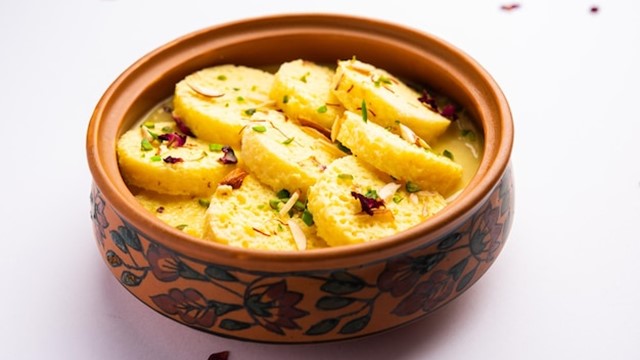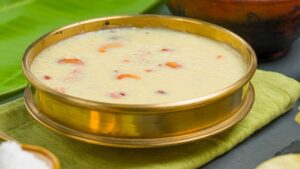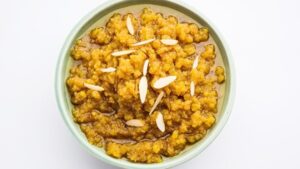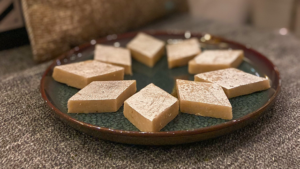Rasmalai, the creamy Indian dessert, is not just a treat for the taste buds but a delightful experience to be relished. The presentation and serving of Rasmalai contribute significantly to enhancing its indulgent appeal. Here’s how to serve and enjoy this luscious dessert:
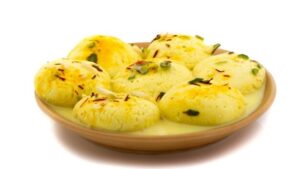
Origins and Cultural Significance of Rasmalai: A Culinary Heritage
Rasmalai, a revered dessert in Indian cuisine, traces its origins to the eastern state of West Bengal, a region renowned for its rich culinary heritage. The name “Rasmalai” itself signifies its essence—‘ras’ meaning juice or essence, and ‘malai’ translating to cream.
Historical Roots:
Bengal’s Culinary Legacy:
Rasmalai’s inception can be traced back centuries, evolving from the already beloved Rasgulla, a spongy cheese-based sweet. It is believed that the skilled artisans of Bengal infused creativity by immersing these cheese balls in a creamy, flavored milk base, thereby birthing Rasmalai.
Cultural Adaptation and Evolution:
Initially known as “rossomalai” or “roshomalai,” the dessert underwent adaptations over time, traveling across regions in India and evolving in preparation techniques and flavors, adapting to local preferences while retaining its essence.
The Significance:
Festive Celebrations:
Rasmalai holds immense cultural significance, often gracing celebratory occasions, festivals, weddings, and religious ceremonies across India. Its presence on auspicious occasions symbolizes joy, abundance, and prosperity, reflecting the sweetness of shared moments.
Culinary Tradition:
Beyond being a dessert, Rasmalai embodies a connection to culinary tradition—a sweet ambassador representing the artistry and diversity of Indian sweets. Its evolution and adaptation showcase the amalgamation of flavors and techniques passed down through generations.
Culinary Artistry:
Meticulous Craftsmanship:
The creation of Rasmalai involves intricate steps, from curdling milk to create cheese patties, simmering them in sugar syrup, and submerging them in creamy, saffron-infused milk. Each step demands precision and expertise.
Flavor Symphony:
Rasmalai harmonizes the sweetness of milk with the delicate texture of the cheese patties, often infused with cardamom, saffron, and garnished with nuts—creating a symphony of flavors that tantalize the taste buds.
Conclusion:
Rasmalai isn’t merely a dessert; it embodies the essence of India’s culinary craftsmanship and cultural heritage. Its journey from Bengal to becoming a cherished sweet across the nation speaks volumes about its universal appeal and cultural significance.
Embracing Tradition:
Rasmalai’s historical roots and cultural importance reflect the richness of Indian traditions, encouraging generations to celebrate not just the sweetness it offers but also the shared moments and culinary legacies it represents—an enduring symbol of joy and togetherness.
In each spoonful of Rasmalai, there’s a narrative—a tale of evolution, artistry, and cultural pride—an invitation to savor not just its flavors but the richness of India’s culinary legacy.
Origins and Significance
Rasmalai, deriving its name from two Hindi words—’ras’ meaning juice or essence and ‘malai’ meaning cream—is a dessert deeply rooted in the culinary heritage of India. Believed to have originated in Bengal, this delicacy has now spread its sweet influence across the Indian subcontinent and beyond.
The preparation of Rasmalai involves soft, spongy cheese patties, known as ‘chenna’ or ‘paneer,’ immersed in sweetened, thickened milk infused with cardamom, saffron, and various nuts. These delectable cheese dumplings soak up the creamy essence, creating a harmonious blend of flavors that captivate the palate.
Crafting the Perfect Rasmalai
The art of making Rasmalai involves meticulous steps and precision, demanding patience and expertise. To begin, fresh milk is curdled to obtain the cheese, which is then kneaded, shaped into small balls, and gently flattened to form discs. These discs are then poached in a simmering syrup until they swell up and turn spongy, ready to absorb the flavors of the milk.
Meanwhile, a creamy concoction of reduced milk, sugar, and aromatic ingredients like cardamom, saffron, and sometimes rose water is prepared. Once the cheese discs are cooked, they are delicately placed in this sweetened milk mixture, left to steep and absorb its lusciousness, resulting in the iconic Rasmalai.
Symphony of Flavors
Rasmalai: A Harmonious Symphony of Exquisite Flavors
Rasmalai, the jewel among Indian desserts, orchestrates a symphony of flavors that dance gracefully on the palate, creating an unforgettable culinary experience. This delicacy is a harmonious blend of distinct tastes, each contributing to its lusciousness:
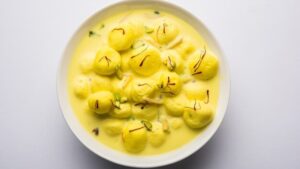
Saffron’s Elegance:
Saffron, the golden-hued spice revered for its subtle yet profound aroma, lends Rasmalai its signature fragrance and a delicate touch of floral sweetness. Infusing the milk base with saffron strands elevates the dessert’s allure, imparting a royal hue and a subtle hint of luxury to every spoonful.
Cardamom’s Complexity:
Cardamom, with its warm and aromatic essence, weaves a tapestry of complexity into Rasmalai. Crushed cardamom pods or powdered seeds infuse the sweetened milk with a gentle warmth, adding layers of depth to the dessert’s flavor profile and complementing the richness of the creamy base.
Nutty Indulgence:
The garnishing of slivered almonds and pistachios introduces a delightful nuttiness, creating a textural contrast that elevates Rasmalai to new heights. These nuts offer a pleasant crunch, imparting not only visual appeal but also a rich, earthy essence that harmonizes with the creamy sweetness.
Creamy Sweetness:
At the heart of Rasmalai lies its essence—a concoction of sweetened milk that envelopes the soft cheese patties. The richness of whole milk simmered with sugar forms the luxurious foundation, offering a velvety canvas for the other flavors to intertwine, creating a decadent and indulgent experience.
Sublime Union:
The artful combination of saffron’s elegance, cardamom’s complexity, nutty indulgence, and creamy sweetness orchestrates a symphony of flavors in Rasmalai. Each element plays its part, contributing to a culinary masterpiece that delights the senses and lingers in memory long after the last spoonful.
Conclusion:
Rasmalai, with its symphony of saffron’s regal charm, cardamom’s enchanting warmth, nutty indulgence, and creamy sweetness, transcends the realm of mere desserts. It embodies a perfect balance of flavors—a melody that tantalizes taste buds and evokes an appreciation for the artistry of Indian sweets.
Embrace the Symphony:
Savoring Rasmalai isn’t just about relishing a dessert; it’s about immersing oneself in a symphony of flavors—a melodious journey that invites appreciation for the intricate blend of ingredients, techniques, and cultural significance woven into this divine creation.
With every spoonful of Rasmalai, indulge in this sublime symphony—a fusion of flavors that celebrates the richness of India’s culinary heritage, leaving a sweet, lingering melody that resonates within.
Recipe
Ingredients:
For the Cheese Patties (Rasgullas):
- 4 cups whole milk
- 2 tablespoons lemon juice or vinegar
- 2 cups water
- 1 cup sugar
For the Sweetened Milk:
- 4 cups whole milk
- 1/2 cup sugar
- 4-5 crushed cardamom pods (or 1/2 teaspoon cardamom powder)
- A pinch of saffron strands
- Slivered almonds and pistachios for garnish
Instructions:
Making Cheese Patties (Rasgullas):
- Curdling the Milk: In a heavy-bottomed pan, bring 4 cups of milk to a boil. Gradually add lemon juice or vinegar while stirring gently. The milk will curdle, separating into curds and whey.
- Straining and Draining: Place a muslin cloth or cheesecloth over a colander and strain the curdled milk. Rinse the cheese under cold water to remove any residual taste of the lemon juice or vinegar. Squeeze out excess water and hang the cloth for about 30 minutes to drain excess liquid from the cheese.
- Kneading and Shaping: After draining, knead the cheese until smooth. Divide it into portions and shape them into small balls. Gently flatten each ball to form discs.
- Preparing Sugar Syrup: In a separate pot, combine 2 cups of water and 1 cup of sugar. Bring it to a boil, ensuring the sugar dissolves completely.
- Cooking the Cheese Patties: Carefully drop the cheese discs into the boiling sugar syrup. Cover and cook on medium heat for about 12-15 minutes until they swell up and become spongy. Remove from heat and allow them to cool in the syrup.
Preparing Sweetened Milk:
- Boiling Milk: In another pan, bring 4 cups of milk to a boil. Add sugar, crushed cardamom pods (or cardamom powder), and a pinch of saffron strands.
- Simmering and Reducing: Simmer the milk on low heat for 10-15 minutes, stirring occasionally, until it thickens slightly. Remove from heat and let it cool.
Assembling Rasmalai:
- Combining Cheese Patties with Sweetened Milk: Gently squeeze excess syrup from the cooled cheese patties and place them in the prepared sweetened milk. Allow them to soak in the richness of the milk.
- Chilling and Garnishing: Refrigerate the Rasmalai for a few hours to chill and allow the flavors to meld. Before serving, garnish with slivered almonds and pistachios.
Enjoy the creamy, indulgent delight of homemade Rasmalai, a dessert that captivates with its luxurious textures and exquisite flavors!

